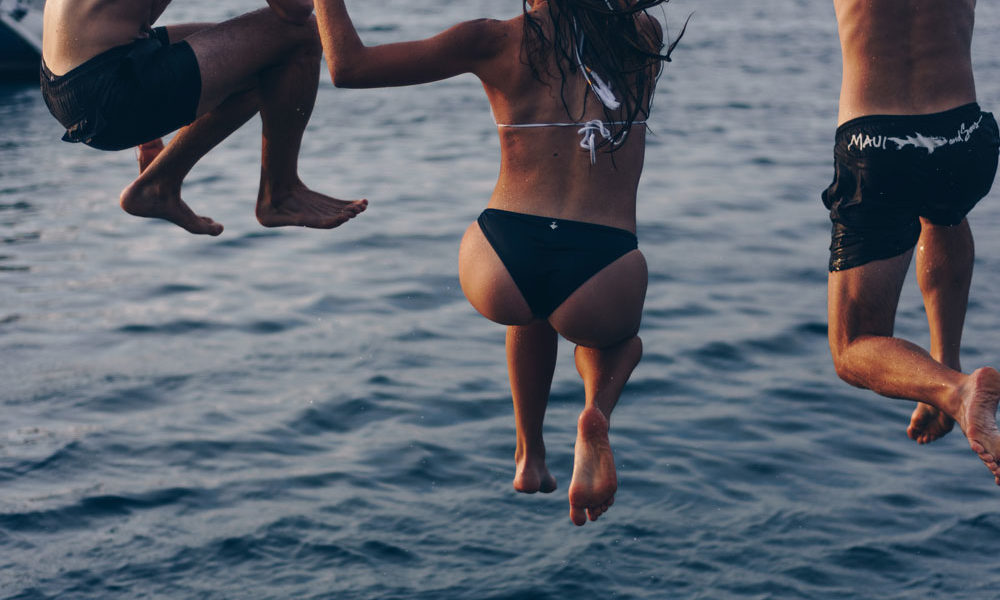There’s cold. And then there’s an unnimaginably icy water dip—that’s hair raising, gives you goosebumps and makes you shiver. How do you even prepare for that? How do you even enjoy it?
Noelle Smith, owner of @ellenoiredundas and ellenoire.com, loved her New Year’s Polar Dip that she did to start 2022 in the coldest way possible: jumping into the Salish Sea off Vancouver Island. Aside from the freezing water, it was snowing and windy. She felt so empowered from the experience that she’s doing a “30 days of five-minute cold showers” challenge. Just saying she’ll hop into cold water reveals to her how “amazing how you can talk your way out of something that seems impossible or ridiculous from the comfort of your couch.”
(That’s exactly where I am right now, writing this, unable to imagine running upstairs to get down to the buff just to shiver under the showerhead. But I’m impressed.)
“The polar dip was at the end of a vacation I expected to be very quiet and relaxing,” says Smith. “Instead, I ended up going back-country snow-shoeing up a mountain two days in a row. The route we took on the first day took five hours to get up and back and was so high our mountain guides had avalanche transceivers on. After 30 kilometres of snowy fun over four days, when I was asked to do the New Year’s Day Polar Dip I had to say yes. It was like we had lost our minds but we just did it and it was a perfect way to end an amazing spirit renewing trip.”
Here’s a 30-day abs challenge one of our editors did.
The benefits of cold water
Cold water has been said to do many things: Increase circulation, burn fat, boost immunity and more. But as you can imagine, some of the rumoured benefits are slivers of truth taken from small studies. The weight-loss claim, for example, is an inflated one. The body’s attempt to increase its temperature after exposure to cold does slightly increase the metabolism, but not enough to burn fat, according to the Cleveland Clinic. If that were the case, Canadians would never know experience winter weight gain, right?!
As for what is true, exposure to cold temperatures has been used medically to treat inflammation, pain and to lower core body temperature (like with a fever or heat stroke). Also, brief exposure to cold water can increase alertness and temporarily increase circulation too, reports the British Journal of Sports Medicine, which is likely what made Smith feel so exhilarated during her dip.
What exactly inflammation does to the body – and how to deal.
How to prepare for a cold-water dip
On April 2, 2022, over 400 people took part in Toronto Ice Breaker: The Largest Cold Plunge Lake Ontario. So I had to ask the organizers how one preps and recovers from a cold-water dip. They tell me the intent was to celebrate resilience from the effects of the pandemic over the past two years and to have fun in a safe and healthy way outside.
Adam Lewis, head of partnerships at Othership, and mindfulness coach Brian Coones at City Shred share their tips.
What to do before a cold-water dip
Breathe. Do one to five minutes of breathwork to prepare the body, says Lewis. “This may look like one full of circular breathing in and out fully through the mouth as gentle hyperventilation and then engaging in breath retention, repeating for a couple rounds.”
Move. Yes, do a warmup. Lewis recommends bodyweight squats, moving your arms as you go up and down.
Think positive. Tell yourself you got this! “This helps not only calm the mind but also can serve as a mental queue for the plunger to anchor their mind to in moments of discomfort during the time in the cold water,” says Lewis.
The proper form for squats – and a squats challenge with real results.
What to do after a cold-water dip
Bring warm clothes. “Get a layer ready to put on, as you’ll get a heavy shiver as you settle into the transition trying to warm itself,” says Coones.
Keep moving. Think like a warm-up cool-down; just like you would keep moving after an exercise to help your heart rate get back to normal levels. “The ideal best position is a horse stance,” says Coones. Position your legs in a wide-squat stance. Go up and down to both engage the muscles and stretch them too. And move your arms from a T-position, waving in front of the body, back and forth.
Relax. Let your body return to its regular temperature in due course, says Coones, as you encourage it with the above two tips. The body is stressed from the cold and is working to increase blood flow to the skin. Let it do its job.
The hand creams tough enough to handle hand sanitizer.
If you sign up for a cold-water dip, have fun and be social. Smith says she found warmth with “dry clothes in the car waiting for us,” and a hot mug of tea by a wood stove at a friend’s house nearby.
Heart-warming, isn’t it?

